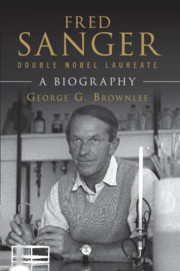Book contents
- Frontmatter
- Dedication
- Contents
- List of figures
- Foreword
- Acknowledgements and original sources
- Brief chronology
- Honours
- Introduction
- 1 A Quaker upbringing
- 2 How about studying insulin?
- 3 Radioactive sequencing of proteins and nucleic acids
- 4 Interview of Fred by the author in 1992: Early life
- 5 Interview of Fred by the author in 1992: Insulin and the Biochemistry Department, University of Cambridge
- 6 Interview of Fred by the author in 1992: Nucleic acids at the MRC Laboratory of Molecular Biology, Cambridge
- 7 Post-Sanger sequencing: high-throughput automated sequencing
- 8 Cancer: the impact of new-generation sequencing
- 9 Commentaries on Fred Sanger’s scientific legacy
- Epilogue
- Appendix: Complete bibliography of Fred Sanger
- Notes
- Index
- Plates
3 - Radioactive sequencing of proteins and nucleic acids
Published online by Cambridge University Press: 05 November 2014
- Frontmatter
- Dedication
- Contents
- List of figures
- Foreword
- Acknowledgements and original sources
- Brief chronology
- Honours
- Introduction
- 1 A Quaker upbringing
- 2 How about studying insulin?
- 3 Radioactive sequencing of proteins and nucleic acids
- 4 Interview of Fred by the author in 1992: Early life
- 5 Interview of Fred by the author in 1992: Insulin and the Biochemistry Department, University of Cambridge
- 6 Interview of Fred by the author in 1992: Nucleic acids at the MRC Laboratory of Molecular Biology, Cambridge
- 7 Post-Sanger sequencing: high-throughput automated sequencing
- 8 Cancer: the impact of new-generation sequencing
- 9 Commentaries on Fred Sanger’s scientific legacy
- Epilogue
- Appendix: Complete bibliography of Fred Sanger
- Notes
- Index
- Plates
Summary
The lean years
Fred described 1955–64 as his ‘lean years’ as he published relatively little then. In fact, this was a transitional period in which Fred was exploring completely new ideas for sequencing proteins. His idea was to radioactively label proteins. After radioactively labelling a protein and then isolating a radioactive peptide, he would work out the sequence around the labelled amino acid, indirectly. For example, he would use various modifications of the peptide, e.g. removal of the N-terminal amino acid, and monitor changes in the mobility of the peptide on paper chromatography or paper electrophoresis. He was using the position of the peptide as a way of sequencing.
This new way of thinking would, in principle, have many advantages. It would not require as much protein as his classical procedures worked out on insulin, since radioactively labelled peptides would be easily and quickly detected on paper by the then relatively new and sensitive method of autoradiography – using an X-ray film. The protein would not necessarily have to be pure, as long as it was radiochemically pure. For example in 1958 Fred incubated an isolated oviduct from a hen with 1 mCi 32P-labelled inorganic phosphate. He successfully isolated 32P-labelled ovalbumin, which was known then to contain two serine phosphates. Fred correctly deduced the presence of one phosphate-containing dipeptide, as serine phosphate-alanine, an observation confirmed ten years later by classical methods of peptide sequencing. Twenty years later on in 1978, in a very different era of DNA sequencing, my colleagues and I showed the exact position of this dipeptide in ovalbumin, as deduced from the nucleotide sequence of a cDNA clone of ovalbumin mRNA.
- Type
- Chapter
- Information
- Fred Sanger - Double Nobel LaureateA Biography, pp. 16 - 39Publisher: Cambridge University PressPrint publication year: 2014



